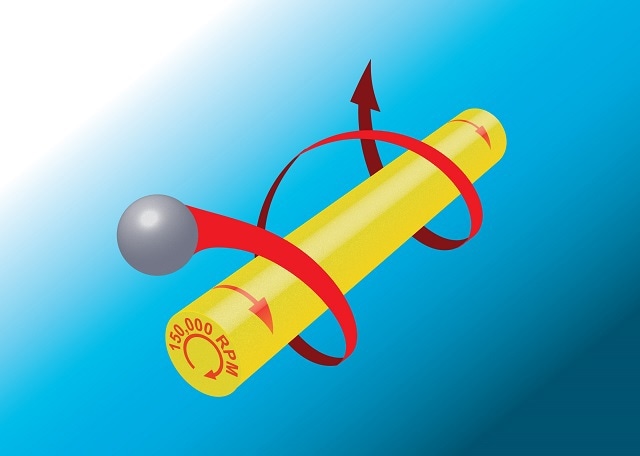Jul 28 2014

Image Credit: Balk/NIST
Over the last several years scientists from the National Institute of Standards and Technology (NIST) have been studying how to make nanomotors move around when suspended in a liquid. In 2012 a team of scientists from Penn State first observed that metal nanorods would rotate in response to ultrasound, but the reason why has baffled scientists since its discovery. The research conduct by the NIST could now offer new insight and applications inside the human body.
Spinning Nanorods
Vibrating a solution of rod-shaped metal nanoparticles in water and applying ultrasound will result in the nanorods spinning around their long axes similar to a drill bit. No one yet knows why this phenomenon occurs, but the team from NIST have recorded speeds of up to 150,000 revolutions per minute.
The nanomotors created by the team rotate ten times faster than any other nanoscale object submerged in a liquid.
The discovery was first observed by scientists from Penn State who reported that the metal nanorods were rotating in response to ultrasound. Another team of scientists at the University of California San Diego later observed that they could direct the metal rods’ forward using a magnetic field. Further studies then demonstrated that these nanomotors could be propelled inside of a cancer cell.
Video Courtesy of NIST - Clip shows a nanoparticle tracing the microvortical flow around a rapidly rotating nanorod propelled by ultrasound.
However, none of the research undertaken was able to explain why or how fast these nanomotors were spinning.
How Fast?
To answer this question, Samuel and his team mixed 2-micrometer-long, 300-nanometer wide gold rods with 400-nanometer wide polystyrene beads in a water solution. The solution was then sandwiched between glass and silicon plates with a shaker beneath.
If nanomotors are to be used in a biological environment, then it is important to understand how they interact with the liquid and objects around them. We used nanoparticles to trace the flow of water around the nanomotors, and we used that measurement to infer their rate of rotation. We found that the nanomotors were spinning surprisingly rapidly.
Samuel Stavis, Project Leader at NIST
The shaker was then vibrated at an ultrasonic frequency of 3 megahertz and the team observed the resulting motion.
The rotating nanomotors create a vortex in the water which sucks in any beads that get to close. This forces the beads to swirl around the rods and by measuring how far the beads are from the rods and how fast they move, the team was able to work out how quickly the motors were spinning.
"The size of the nanorods is important in our measurements" says NIST physicist Andrew Balk. "We found that even small variations in the rod's dimensions cause large measurement uncertainties, so they need to be fabricated as uniformly as possible for future studies and applications."
Samuel and his team also reported that the speed of rotation appears to be independent of their forward motion. If the team are able to control the speed and feed of the nanomotors, it may open possible applications in rotary tools used in machining and mixing.
Where Will This be Used?
Future applications for this new technology are yet to be solidified, but it could offer huge potential for biological applications.
Our study is a step toward understanding the behavior and fulfilling the potential of this dynamic nanotechnology for biological applications, as well as other applications involving nanoscale transport, mixing, machining, assembly, and rheology.In particular, our study quantifies how nanorod rotation can control the transport of nanoparticles by microvortical flows. The enhanced mixing of liquids at microscopic length scales follows naturally from our results, while the use of nanorods as rotary tools is a possibility with rotation occurring at kilohertz frequencies.
Samuel Stavis, Project Leader at NIST
References